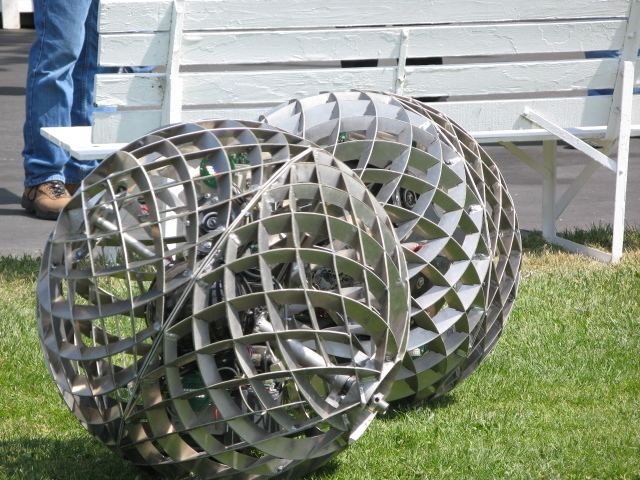Open-source robotics (OSR) is a branch of robotics where the physical artifacts of the subject are offered by the open design movement. This open design movement applied to the field of robotics makes use of open-source hardware and free and open source software providing blueprints, schematics, and source code. The term usually means that information about the hardware is easily discerned so that others can make it—coupling it closely to the maker movement.
App Inventor for AndroidBlueBots, free bluetooth remote for custom bluetooth projects, such as robotics. Works with Arduino (as Arduino Mega).Amarino, a toolkit, basically consisting of an Android application and an Arduino library.NXJ An open-source Java programming environment for the Lego NXT robot kit (http://lejos.sourceforge.net/)CLARAty Robotics software developed by JPL as part of the Mars program.ROS (Robot Operating System) (open-source BSD software )URBI (C++ distributed/embedded components framework + parallel/event-driven orchestration script language)Player (robot framework)Orocos, C++ framework for component-based robot control softwareRock (the Robot Construction Kit) (Software integration framework for robotic systems based on Orocos/RTT.)Orca (robot framework)MOOS (robot framework)MyRobotLab (robot framework)RoboComp (robot framework)RUBICSCARMEN (robot simulator)TeamBots (robot simulator)Open Dynamics Engine (physics engine for modelling articulated rigid-body dynamics)ROS (Robot Operating System) provides libraries and tools to help software developers create robot applications. It provides hardware abstraction, device drivers, libraries, visualizers, message-passing, package management and more. ROS is licensed under an open source, BSD license. Currently running on 50+ robotsRobot Overlord a open source Java / OpenGL multi-robot simulator.Simbad robot simulator (robot simulator)Gazebo (multi-robot simulator)STDR Simulator (multi-robot 2D simulator)Dave's Robotic Operating SystemSparky Telepresence ControllerHome brew robot software running on the consumer robotic platform SpykeeOpenJAUS (robot / unmanned systems framework)RI-JAUS SDK A cross-platform, GPL-licensed C++ SDK implementing the JAUS protocol for robot control.OpenRTM-aist (robotics technology middleware)Open Platform for Robotic Services Component based framework, GUI editors in Eclipse and a Simulator, OPRoS ComponentsminiBloq a graphical programming interface that allows to program robotic boards (Arduino Compatibles) without previous knowledge of programmingArtoo a Ruby microframework for robotics and physical computingEEROS, an Easy, Elegant, Reliable, Open and Safe Real-Time Robotics Software FrameworkLSTS Toolchain is a set of tools and frameworks for the development of Networked Robot Systems.Make Controller KitMotherboards with open-hardware CPUBased in Arduino (Arduino Mega) and using AIDE (Arduino Software IDE). Can include Bluetooth4arduino and Magician Chassis / Ardumoto Based in Raspberry Pi The Rossum project open-sources certain robotic modules and tools (mappers, robot simulators, encoder designers, ...)Lower-cost. Costs of a robot can be decreased dramatically with prominent examples being the robots being built by Hanson ($300) and project aiko ($25000)Interchangeable software and/or hardwareA first sign of the increasing popularity of building robots yourself can be found with the DIY community. What began with small competitions for remote operated vehicles (e.g. Robot combat), soon developed to the building of autonomous telepresence robots as Sparky and then true robots (being able to take decisions themselves) as the Open Automaton Project and Leaf Project. Certain commercial companies now also produce kits for making simple robots.
At present, open-source robots are not yet sophisticated enough to perform much of the tasks a person can do, nor perform difficult or complicated tasks that only robots may—one day—provide; this being:
metalworks (precise metal sheets and pipe-bending, sheet/pipe cutting; e.g. via Multimachine and/or other embedded tools as cramps, pliers, ...)translator for many languages (including the main languages as Mandarin, English, Spanish, Bengali, Hindi, etc.)calorie-counter for the robot-owner; counting the calories of food items the owner eats and preventing him from eating more that day when he reaches 2000 kcalbuilding electronic circuitry (PCB-boards)transportation; this e.g. by riding on the back, similar as on a horse (the latter allowing the robot to return to the appearance of a normal person after disembarking)personal protection (robots, being made of metal, are able to withstand quite some beating and may be taught to incapacitate attackers by punching or Less-lethal weapons)bomb disposal and/or the making of explosive compounds for bomb disposal (e.g. on the owner's farming fields e.g. in developing countries as Cambodia, countries south and north of the sahara as Angola, Western Sahara, Libia, ..) or destruction of obstacles or to prepare building sitesproviding communication through a small computer (e.g. Linutop, EeeBox, gPC, and integrated satellite Internet uplink or long-range Wi-Fi or WiMAX-antenna). The type of communication may include: active searching on webpages (browsing), e-mail, text and or audio based communication with others (e.g. VoIP calls; both to distant users via Internet as local VoIP-communication to team members in close proximity), ...The use of RepRaps and other 3-D printers for rapid prototyping, art, toy manufacturing, educational aides, and open-source appropriate technologyDespite this however, some DIY builders are already looking to helpful activities that can be performed today as vacuum cleaning, floor washing and automated mowing.

